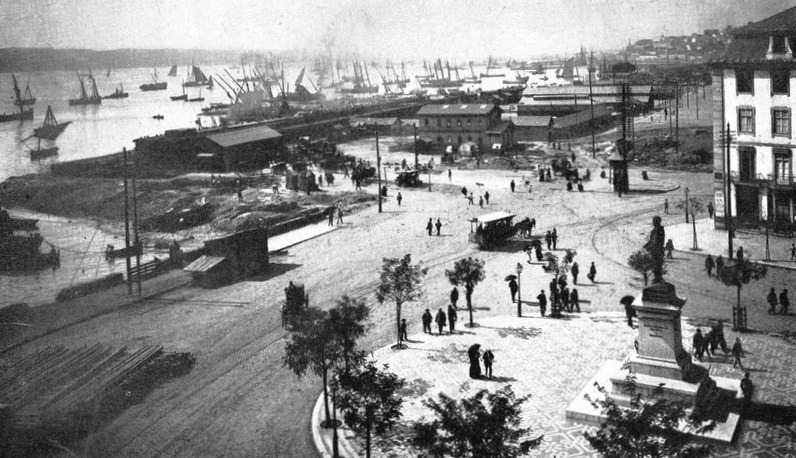Cais do Sodré on:
[Wikipedia]
[Google]
[Amazon]
Cais do Sodré is an area in the center of
 Cais do Sodré was known at the beginning of the 19th century as Bairro dos Remolares.
From 1855 onwards, several works were carried out to transform this unhealthy place into a landmark in the city of Lisbon at the time. Warehouses were built, fishing sailors began to live in the neighborhood, entrepreneurs linked to the import and export industry opened businesses in the neighborhood. Everyone benefitted from the proximity of the port and international commercial connections.
With the arrival of these groups, Cais do Sodré was already a social reference at the end of the 19th century. It was a stage for intellectuals, bourgeoisie, dandies, artists and upper class individuals, especially at the Hotel Central, described by Eça de Queirós in his work Os Maias.
By 2019 it was a historic and vibrant neighborhood, becoming one of the liveliest and busiest places in Lisbon. It is famous for its nightlife, especially on Pink street ( Rua Nova do Carvalho), with several entertainment options, from bars, restaurants and nightclubs.
Cais do Sodré was known at the beginning of the 19th century as Bairro dos Remolares.
From 1855 onwards, several works were carried out to transform this unhealthy place into a landmark in the city of Lisbon at the time. Warehouses were built, fishing sailors began to live in the neighborhood, entrepreneurs linked to the import and export industry opened businesses in the neighborhood. Everyone benefitted from the proximity of the port and international commercial connections.
With the arrival of these groups, Cais do Sodré was already a social reference at the end of the 19th century. It was a stage for intellectuals, bourgeoisie, dandies, artists and upper class individuals, especially at the Hotel Central, described by Eça de Queirós in his work Os Maias.
By 2019 it was a historic and vibrant neighborhood, becoming one of the liveliest and busiest places in Lisbon. It is famous for its nightlife, especially on Pink street ( Rua Nova do Carvalho), with several entertainment options, from bars, restaurants and nightclubs.
Lisbon
Lisbon ( ; ) is the capital and largest city of Portugal, with an estimated population of 567,131, as of 2023, within its administrative limits and 3,028,000 within the Lisbon Metropolitan Area, metropolis, as of 2025. Lisbon is mainlan ...
, Portugal, between Cais da Marinha and Cais do Gás. This name is shared by two railway stations and a ferry station in Lisbon
Lisbon ( ; ) is the capital and largest city of Portugal, with an estimated population of 567,131, as of 2023, within its administrative limits and 3,028,000 within the Lisbon Metropolitan Area, metropolis, as of 2025. Lisbon is mainlan ...
, Portugal:
* Cais do Sodré railway station
The Cais do Sodré Railway Station () is an intermodal Train station, railway station in the Freguesia (Portugal), civil parish of Misericórdia, in the Concelho, municipality of Lisbon, serving as the terminus of the Cascais Line, suburban r ...
* Cais do Sodré (Lisbon Metro)
* Cais do Sodré, ferry station (allowing for quick travel between Lisbon and Cacilhas, Seixal
Seixal () is a Portugal, Portuguese city and municipality, located in the district of Setúbal District, Setúbal, in the metropolitan area of Lisbon region, Lisbon. Its population includes 184,269 inhabitants (2011), in an area of that includes ...
and Montijo)
History
 Cais do Sodré was known at the beginning of the 19th century as Bairro dos Remolares.
From 1855 onwards, several works were carried out to transform this unhealthy place into a landmark in the city of Lisbon at the time. Warehouses were built, fishing sailors began to live in the neighborhood, entrepreneurs linked to the import and export industry opened businesses in the neighborhood. Everyone benefitted from the proximity of the port and international commercial connections.
With the arrival of these groups, Cais do Sodré was already a social reference at the end of the 19th century. It was a stage for intellectuals, bourgeoisie, dandies, artists and upper class individuals, especially at the Hotel Central, described by Eça de Queirós in his work Os Maias.
By 2019 it was a historic and vibrant neighborhood, becoming one of the liveliest and busiest places in Lisbon. It is famous for its nightlife, especially on Pink street ( Rua Nova do Carvalho), with several entertainment options, from bars, restaurants and nightclubs.
Cais do Sodré was known at the beginning of the 19th century as Bairro dos Remolares.
From 1855 onwards, several works were carried out to transform this unhealthy place into a landmark in the city of Lisbon at the time. Warehouses were built, fishing sailors began to live in the neighborhood, entrepreneurs linked to the import and export industry opened businesses in the neighborhood. Everyone benefitted from the proximity of the port and international commercial connections.
With the arrival of these groups, Cais do Sodré was already a social reference at the end of the 19th century. It was a stage for intellectuals, bourgeoisie, dandies, artists and upper class individuals, especially at the Hotel Central, described by Eça de Queirós in his work Os Maias.
By 2019 it was a historic and vibrant neighborhood, becoming one of the liveliest and busiest places in Lisbon. It is famous for its nightlife, especially on Pink street ( Rua Nova do Carvalho), with several entertainment options, from bars, restaurants and nightclubs.
References